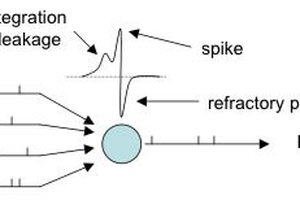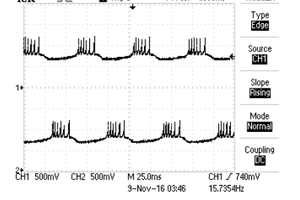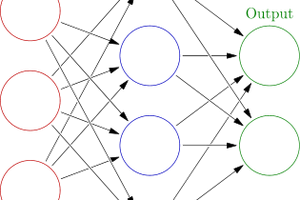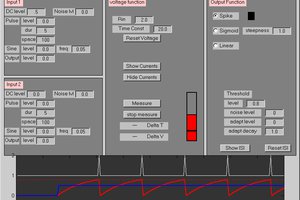We can use the FPGA to do fast numerical integration to solve differential equation models of neurons. This page describes a couple of neuron models and their solution by DDA techniques. Eugene Izhikevich developed a simple, semiempirical, model of cortical neurons. There are two state variables for each neuron: v is the membrane potential and u is the membrane recovery variable. The differential equations, parameter settings and examples of model output are shown in
http://people.ece.cornell.edu/land/courses/ece5760...
with a figure from Izhikevich's web site.
Implementation on the CycloneII FPGA
The model consists of several verilog modules which include (see also Ruben Guerrero-Rivera, et al below):
- Soma model (cell body and spike generator)
- Time constant of 16 time steps (nominal time step of 1/16 mSec)
- Square-law dynamics (as explained in the History section below)
- Settable a, b, c, d, and I parameters (as explained in the diagrams above)
- Spike propagation delay (axon)
- Delays of 1 to 64 time steps to simulate movement of a spike along an axon connection.
- Chemical Synapse
- Constant current source gated by an presynaptic action potential.
- Exponential fall time constant settable at 4, 8, 16, 32, 64, 128, 256 time steps.
- Synaptic weight settable between -1 (inhibitory) and +1 (excitatory).
- Input to daisy-chain current from another synapse module or from a constant current bias.
- Electrical Synapse
- Current determined by a conductance and the voltage difference between two cells.
- Rectifying (foward or backward) and symmetrical versions available.
- Input to daisy-chain current from another synapse module or from a constant current bias.
- Spike time dependent plasticity (STDP)
learning unit to be attached to a synapse.
- The module changes the weight of a synaptic connection depending on whether the postsynaptic spike follows (causal) or leads (non causal) the presynaptic input spike. Causal connnections are made stronger, noncausal weaker.
- Exponential spike intereaction time constant settable at 4, 8, 16, 32, 64, 128, 256 time steps
- The delta-weights for causal and noncausal changes are settable, as are an initial weight and a maximum weight.
Two reciprocal pairs with electrical synapse between them.
The top-level module (and project archive) instantiates 4 neurons with the following connections:
- Neuron 1 spike output is connected to
- Neuron 2 through a synapse with weight -0.016
- Neuron 3 through an electrical synapse with rectification and a conductance of 1/64. Current flow occurs only if
v1>v2. - LED 1
- Neuron 2 spike output is connected to
- Neuron 1 through a synapse with weight -0.016
- LED 2
- Neuron 3 spike output is connected to
- Neuron 4 through a synapse with weight -0.016
- Neuron 1 through an electrical synapse with rectification and a conductance of 1/64. Current flow occurs only if
v1>v2. - LED 3
- Neuron 4 spike output is connected to
- Neuron 3 through a synapse with weight -0.016
- LED 4
The two pairs of cells sync up because the weak excitatory coupling provided by the electrical synapse tend to make cells 1 and 3 fire at the same time. Note that the electrical synapse module needs to know the voltage in both cells and can inject current into both cells.
Reciprocal pair with STDP-modifed synapse to a third neuron
The top-level module (and project archive) instantiates 3 neurons with the following connections:
- Neuron 1 spike output is connected to
- Neuron 2 through a synapse with weight -0.016
- Neuron 3 through a synapse with STDP and an initial weight of zero. The STDP weight increments are adjusted so that the firing of neuron 3 eventually syncs up with neuron one.
- LED 1
- Neuron 2 spike output is connected to
- Neuron 1 through a synapse with weight -0.016
- LED 2
- Neuron 3 spike is not used, just sent to LED 3 for monitoring
The three images below show the initial, unsynced voltages (neuron 1 on bottom, neuron 3 on top), an intermediate state, and the final conveged state generated by the verilog module above....
Read more » Bruce Land
Bruce Land




 JangoJungle
JangoJungle

 Rollyn01
Rollyn01
Wow Bruce this is amazing, I don't fully understand it yet but what my feeble mind can grasp is in awe.